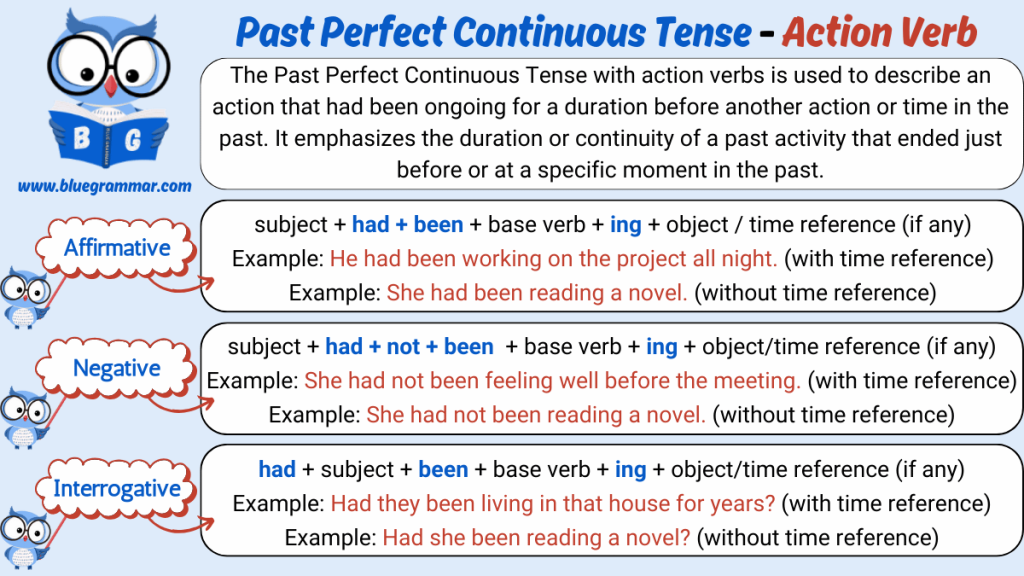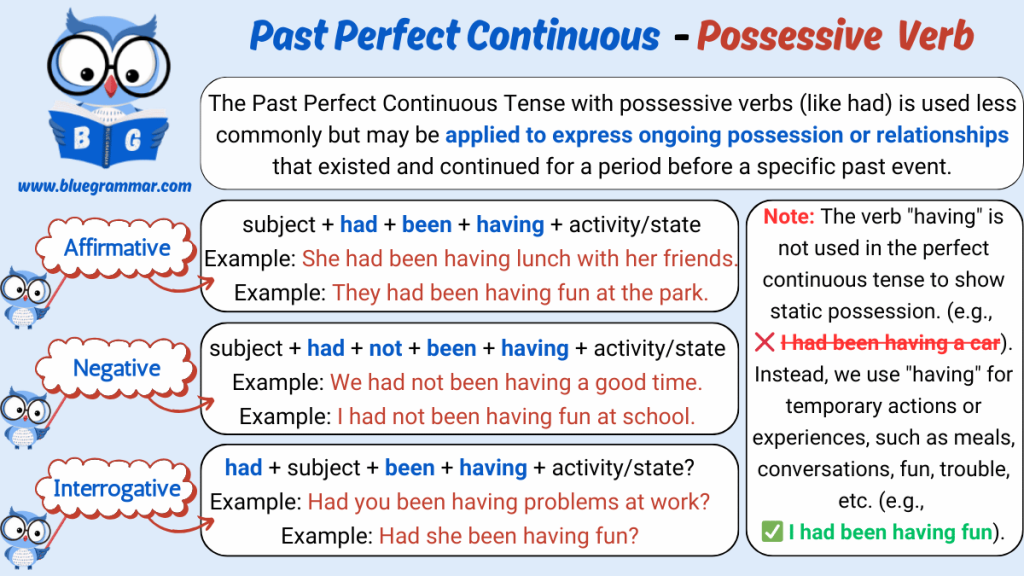
The Past Perfect Continuous Tense is used to describe an action that started in the past, continued for some time, and was still happening or had just stopped before another past action or time. It is useful when we want to emphasize the duration or continuity of an action before something else happened in the past.
Past Perfect Continuous Tense : Action Verb
Why We Use Action Verbs in Past Perfect Continuous?
We use action verbs in this tense to describe physical or mental activities (like work, write, run, study) that had been ongoing before a specific moment or event in the past. This tense helps us show how long an activity had been in progress before something else occurred. It adds depth and context to past events and helps us understand the background of a past situation.
Common Use Cases:
- To show the duration of an action before a past point
- To describe a recently finished action with visible effects in the past
- To give context or cause of another past event
- Often used with time expressions like for, since, before, until, and when

Structure for Positive Sentences
Subject + had been + present participle (verb+ing) + object/time phrase (if any)
- “Had been” is the helping verb for all subjects.
- Use the “-ing” form of the main action verb.
Examples With Duration/Time Reference:
- She had been reading for two hours before dinner.
- I had been working at that company for five years before I quit.
- They had been playing football since morning.
- He had been studying continuously before the test.
- We had been driving for hours before we found a gas station.
Examples Without Time Reference:
- She had been crying before he entered.
- I had been waiting outside.
- They had been arguing when I saw them.
- You had been running too fast.
- He had been thinking about the solution.
Structure for Negative Sentences
Subject + had not been + verb-ing + object/time (if any)
Examples With Duration:
- I had not been sleeping well for a week.
- She had not been attending the classes regularly.
- They had not been living there for long.
- He had not been working since the last month.
- We had not been using the internet before.
Examples Without Duration:
- I had not been listening to the news.
- She had not been feeling well.
- They had not been waiting for me.
- He had not been trying hard enough.
- You had not been focusing on the task.
Structure for Interrogative Sentences
Had + subject + been + verb-ing + object/time?
Examples:
- Had she been cooking for long?
- Had you been studying before the exam?
- Had they been fighting again?
- Had we been living there?
- Had he been practicing the speech?
Past Perfect Continuous Tense : Be Verb
Why We Rarely Use Be Verbs in Continuous Tenses?
Be-verbs (am, is, are, was, were) are state verbs that describe conditions or existence, not actions. Because the Past Perfect Continuous Tense expresses ongoing activities, it is not typically used with stative verbs like be, know, own, believe, or love.
However, “being” can appear in rare formal or descriptive usage, especially when referring to someone’s behavior or role during a certain time period.

Structure for Positive Sentences (Rare Cases)
Subject + had been + being + adjective/noun
Examples:
- She had been being difficult before the manager arrived.
- He had been being helpful all day.
- They had been being noisy until the teacher came.
- I had been being honest, but no one believed me.
- You had been being rude before the apology.
Structure for Negative Sentences
Subject + had not been + being + adjective/noun
Examples:
- He had not been being honest.
- She had not been being careful.
- They had not been being cooperative.
- I had not been being fair in the discussion.
- You had not been being serious.
Structure for Interrogative Sentences
Had + subject + been + being + adjective/noun?
Examples:
- Had she been being rude?
- Had he been being honest with them?
- Had they been being helpful?
- Had I been being too strict?
- Had you been being unfair?
Note: This usage is very formal or rare and is usually avoided in daily conversation.
Past Perfect Continuous Tense : Possessive Verb
Why Possessive Verbs Are Not Used in Past Perfect Continuous Tenses
Possessive verbs like have and has express ownership or relationships (e.g., have a car, have a headache). These are stative verbs, and continuous tenses are generally not used with stative or possessive meanings. However, “have” can act as an action verb in certain contexts (like “having lunch” or “having fun”), and in such cases, it can be used in the Past Perfect Continuous Tense.

Structure for Positive Sentences
Subject + had been + having + noun/object
Examples:
- I had been having breakfast when he called.
- She had been having fun before the argument.
- They had been having a good time.
- He had been having trouble with his studies.
- We had been having a discussion before the phone rang.
Structure for Negative Sentences
Subject + had not been + having + noun/object
Examples:
- I had not been having any luck with the internet.
- She had not been having a good experience.
- They had not been having a peaceful time.
- He had not been having proper meals.
- We had not been having a productive meeting.
Structure for Interrogative Sentences
Had + subject + been + having + noun/object?
Examples:
- Had she been having a headache?
- Had you been having a good time?
- Had he been having problems at work?
- Had they been having any issues?
- Had we been having lunch?
Important Notes:
Use this tense to emphasize ongoing duration before a past event:
- She had been working all day before the guests arrived.
Usually used with time expressions:
- for two hours, since morning, all week, etc.
Do not use Past Perfect Continuous with instantaneous actions (e.g., “fall,” “drop,” “break”).
Avoid using state/stative verbs in continuous form unless they act as action verbs (e.g., have in having dinner is okay).
Do not confuse it with Past Perfect:
- Past Perfect: I had finished my work.
- Past Perfect Continuous: I had been finishing my work for two hours.